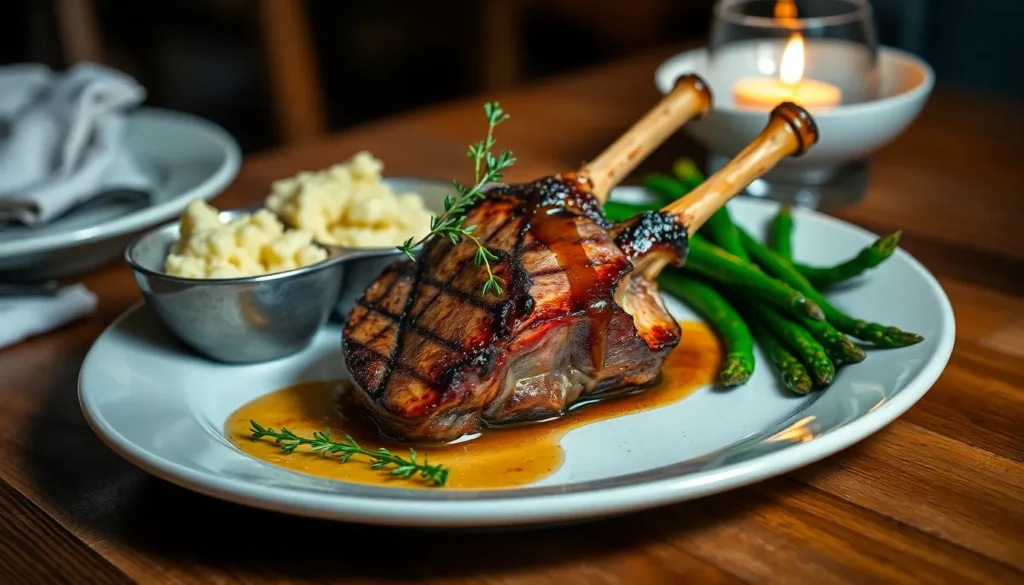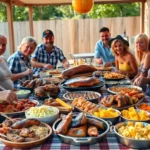When it comes to creating an unforgettable dinner that’ll have your guests talking for weeks, few dishes can match the bold flavors and impressive presentation of a perfectly grilled lamb shank. This succulent cut transforms from tough to tender through the magic of slow grilling, developing a beautiful caramelized crust while staying incredibly juicy inside.
We’ve perfected this technique over countless backyard sessions, and we’re excited to share our foolproof method that guarantees restaurant-quality results every time. The secret lies in our aromatic herb marinade and precise temperature control that breaks down those tough fibers while infusing deep, smoky flavors.
Whether you’re planning a special occasion dinner or simply want to elevate your grilling game, this grilled lamb shank recipe delivers the kind of show-stopping centerpiece that turns any meal into a celebration. Get ready to master one of the most rewarding cuts of meat you can throw on the grill.
Ingredients
Our grilled lamb shank recipe relies on carefully selected ingredients that work together to create layers of flavor and ensure perfect tenderness. We’ve organized these ingredients into three essential components for easy preparation.
For the Lamb Shanks
- 4 lamb shanks (1.5 to 2 pounds each)
- 2 tablespoons kosher salt
- 1 tablespoon freshly ground black pepper
- 2 tablespoons olive oil
For the Marinade
- 1/2 cup red wine
- 1/4 cup balsamic vinegar
- 6 garlic cloves, minced
- 3 tablespoons fresh rosemary, chopped
- 2 tablespoons fresh thyme leaves
- 2 tablespoons Dijon mustard
- 1/4 cup olive oil
- 2 bay leaves
- 1 teaspoon smoked paprika
- 1/2 teaspoon ground cumin
For the Herb Butter
- 1/2 cup unsalted butter, softened
- 3 tablespoons fresh parsley, finely chopped
- 2 tablespoons fresh mint, finely chopped
- 2 garlic cloves, minced
- 1 tablespoon lemon zest
- 1/2 teaspoon sea salt
- 1/4 teaspoon white pepper
Equipment Needed
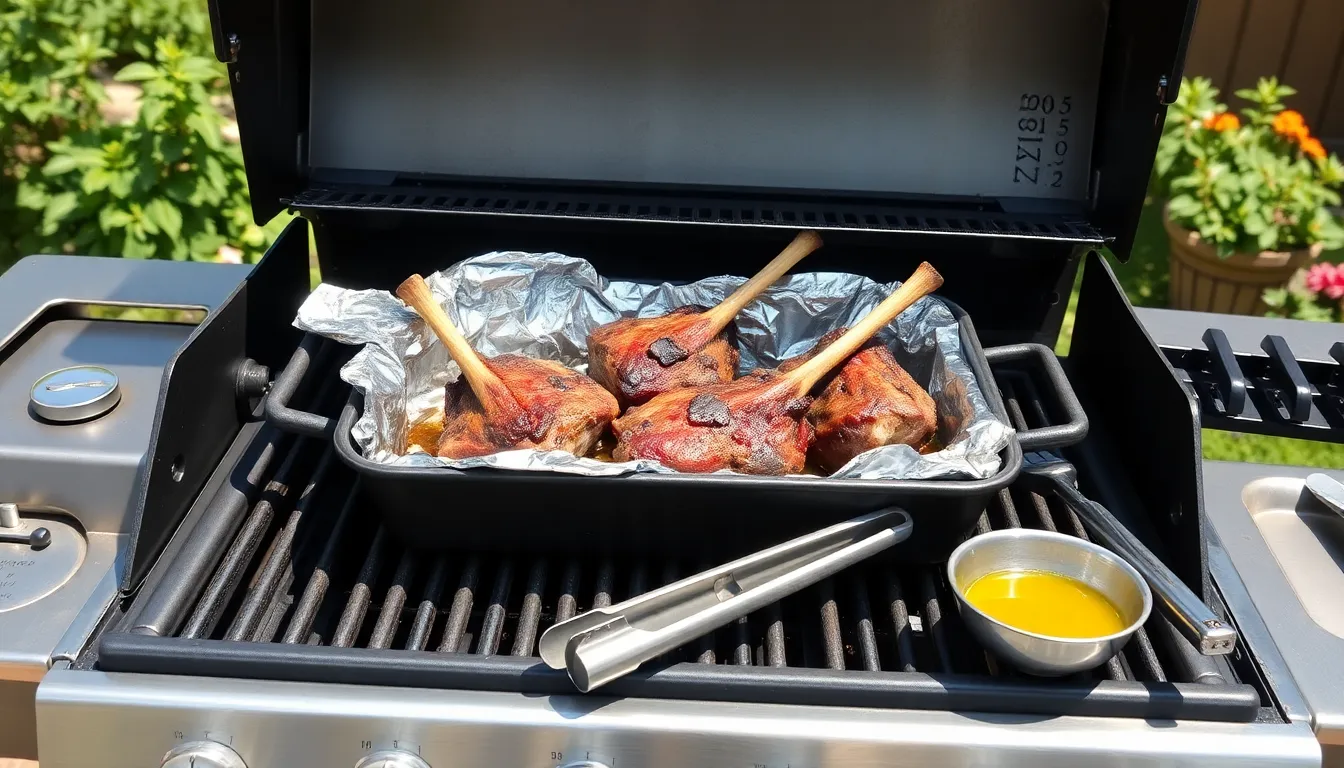
Grilling lamb shanks to perfection requires the right tools to execute both the high-heat searing and low-temperature braising techniques. We’ve identified the essential equipment that makes the difference between good and exceptional results.
Primary grilling equipment forms the foundation of our setup. A grill capable of both direct and indirect cooking works best for this recipe. Gas grills offer precise temperature control while charcoal grills provide authentic smoky flavor. Pellet grills combine both advantages by delivering consistent heat with wood-fired taste.
Heat-proof baking pan serves as our braising vessel during the slow cooking phase. This pan must withstand grill temperatures while holding the lamb shanks and braising liquid. We recommend using a heavy-duty roasting pan or disposable aluminum pan that fits comfortably on your grill grates.
Aluminum foil creates the sealed environment necessary for proper braising. Heavy-duty foil prevents tearing and maintains the steam needed to break down tough connective tissues. We use it to cover the baking pan tightly during the low-temperature cooking phase.
Long-handled tongs provide safe manipulation of the lamb shanks during searing. The extended handles keep your hands away from the heat while allowing precise control when turning the meat. Stainless steel tongs with good grip prevent the shanks from slipping.
Small mixing bowl accommodates marinade preparation and seasoning blends. We use this for combining olive oil with garlic and herbs before applying to the meat. A medium-sized bowl works perfectly for mixing the aromatic ingredients that enhance flavor penetration.
This equipment setup enables the dual cooking method that transforms tough lamb shanks into tender, flavorful masterpieces through our proven grilling and braising technique.
Preparation
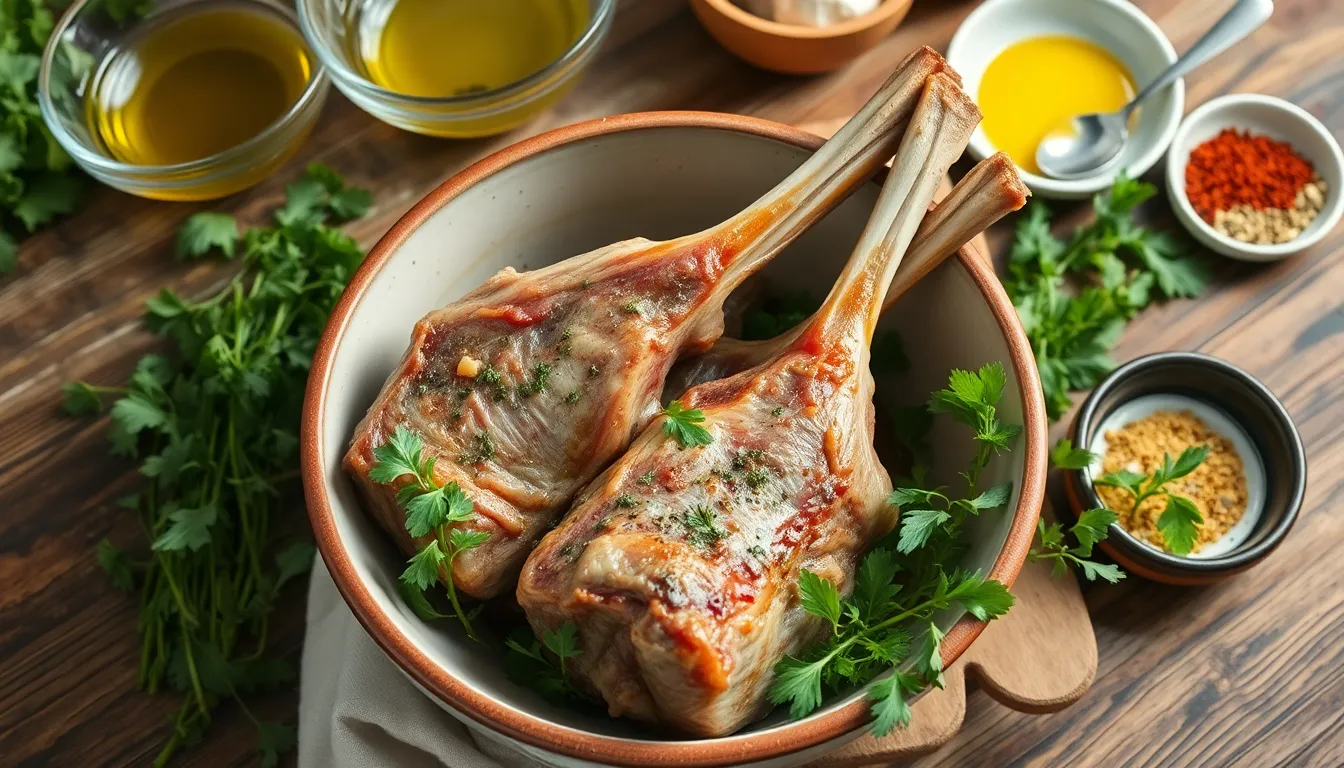
We begin our grilled lamb shank journey with three essential preparation steps that build the foundation for exceptional flavor. This stage requires attention to detail and patience as we create layers of taste that will transform our lamb shanks.
Prep the Marinade
We start by combining our aromatic marinade ingredients in a large mixing bowl or resealable storage bag. Our base marinade includes 2 tablespoons olive oil and 2 tablespoons fresh lemon juice for acidity and tenderizing power. Next we add our herb blend: 1 teaspoon dried rosemary, 1 teaspoon black pepper, ¼ teaspoon dried thyme, ¼ teaspoon dried basil, ¼ teaspoon dried parsley, and ½ teaspoon dried mint. We finish with a pinch of salt and an optional pinch of cayenne pepper for those who enjoy subtle heat.
For those seeking a bolder flavor profile, we can prepare an alternative espresso marinade. This unique blend combines 2 cups strong espresso or coffee with ¼ cup lemon juice, ¼ cup molasses, ½ teaspoon red pepper flakes, 3 tablespoons kosher salt, and 2 tablespoons balsamic vinegar. We thoroughly mix all ingredients until the salt dissolves completely and the mixture becomes uniform.
Marinate the Lamb Shanks
We place our 4 pounds of lamb shanks into the prepared marinade, ensuring each piece is completely submerged for even flavor distribution. The shanks should be turned occasionally during the marinating process to guarantee all surfaces receive equal exposure to the seasoning blend. We recommend refrigerating for at least 1 hour, though overnight marination produces the most tender and flavorful results.
When using the espresso marinade, we extend the marinating time to 4 to 8 hours for optimal flavor penetration and enhanced tenderness. The coffee’s natural acids work alongside the other ingredients to break down tough fibers while infusing rich, complex flavors throughout the meat. We keep the marinating lamb shanks refrigerated and covered during this entire process.
Prepare the Herb Butter
We create our herb butter by bringing butter to room temperature until it becomes easily spreadable. In a small mixing bowl, we combine the softened butter with minced fresh rosemary, chopped parsley, and pressed garlic cloves. The exact proportions can be adjusted to personal taste preferences, but we typically use 2 tablespoons of mixed herbs per stick of butter.
We blend the ingredients thoroughly using a fork or small whisk until the herbs distribute evenly throughout the butter and the mixture becomes smooth and creamy. This aromatic compound butter serves multiple purposes: we can baste the lamb during the final minutes of grilling, spread it over the rested meat before serving, or offer it as a finishing touch at the table. We recommend preparing the herb butter while the lamb marinates, then refrigerating it until needed.
Instructions
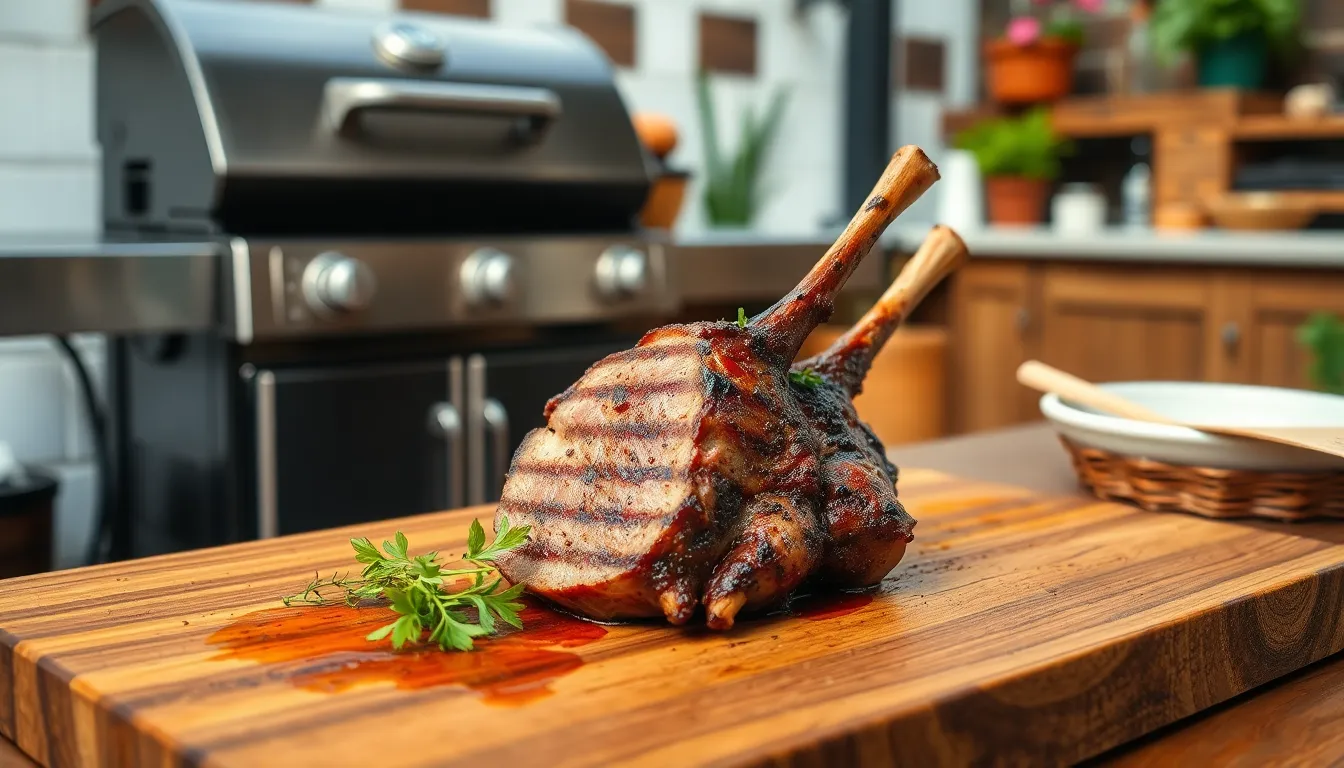
Now that our lamb shanks are properly marinated and our herb butter is ready, we’ll walk through the grilling process that transforms these tough cuts into succulent masterpieces. The key lies in combining high-heat searing with slow, indirect cooking to achieve that perfect balance of caramelized exterior and tender interior.
Preheat the Grill
Fire up your grill to medium-high heat, aiming for around 170°C for the initial searing phase. Gas grill users should preheat for approximately 10 minutes to reach the proper temperature, while charcoal enthusiasts need to ensure their coals are hot and evenly distributed. Set up your grill for both direct and indirect cooking zones, as we’ll need both throughout the process. Clean the grates thoroughly and oil them lightly to prevent sticking during the searing phase.
Sear the Lamb Shanks
Remove the lamb shanks from the marinade and pat them dry with paper towels to ensure proper browning. Place the shanks directly over the hot grates and sear for 5 minutes on each side, creating that coveted caramelized crust that locks in the juices. Use long-handled tongs to turn the shanks carefully, ensuring all surfaces develop that beautiful golden-brown color. The searing process develops complex flavors through the Maillard reaction, so don’t rush this crucial step.
Slow Grill the Shanks
Move the seared lamb shanks to the indirect heat zone and reduce the temperature to 275°F (135°C). Place the shanks in your heat-proof baking pan and cover tightly with heavy-duty aluminum foil to create a braising environment. Cook for 3 to 4 hours, checking occasionally and basting with the herb butter every hour. This low and slow method breaks down the tough connective tissue, transforming the meat into fork-tender perfection while infusing it with smoky flavors.
Check for Doneness
Test the lamb shanks for doneness by piercing them with a fork – the meat should offer little resistance and begin pulling away from the bone. The internal temperature should reach 190-205°F for that coveted fall-off-the-bone tenderness. Visual cues include the meat shrinking back from the bone ends and a rich, mahogany color developing on the surface. Trust both your thermometer and your eyes when determining the perfect doneness.
Rest and Serve
Remove the lamb shanks from the grill and tent them loosely with foil, allowing them to rest for 10 to 15 minutes. This resting period allows the juices to redistribute throughout the meat, ensuring maximum tenderness and flavor in every bite. Brush with any remaining herb butter or drizzle with the pan juices before plating. Serve immediately while still warm, garnished with fresh herbs if desired.
Grilling Tips for Perfect Lamb Shanks
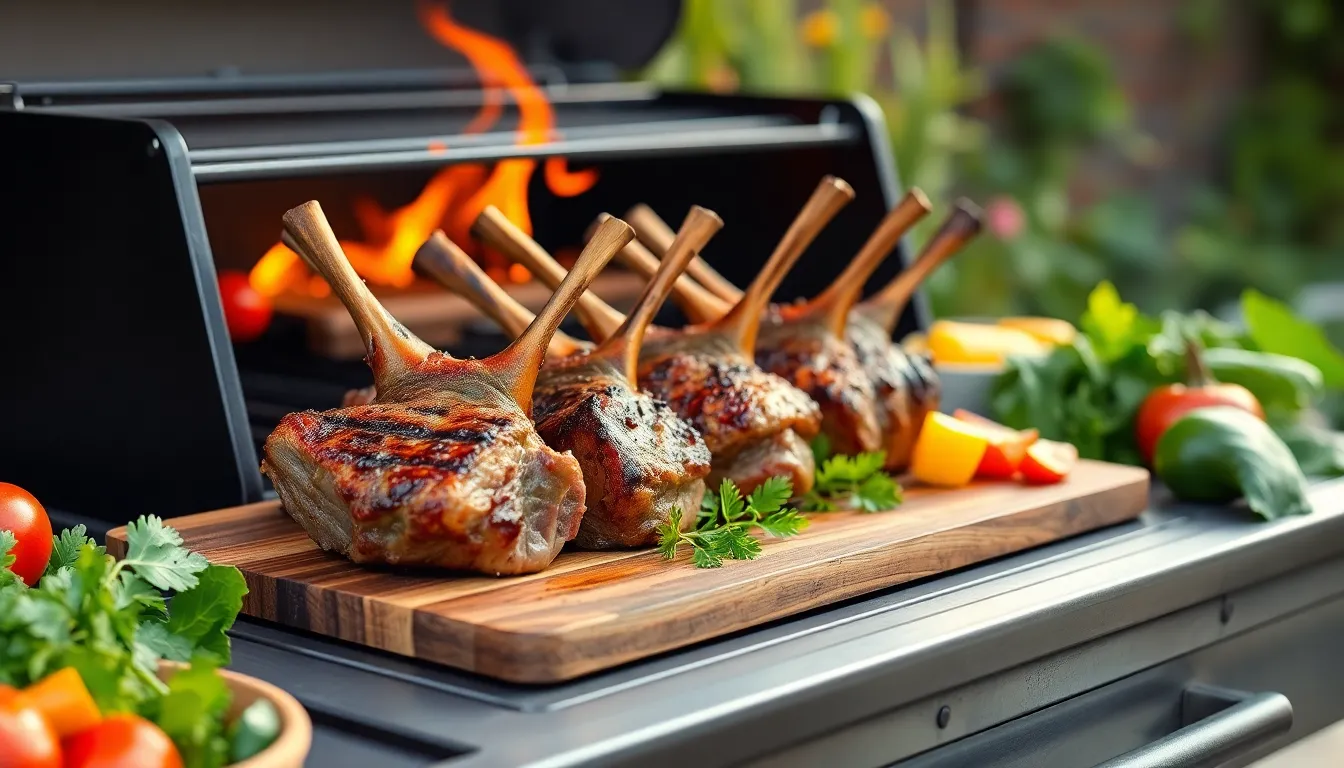
Mastering the art of grilled lamb shanks requires understanding the unique challenges this cut presents. We’ve discovered that these tough cuts contain important connective tissue that demands patience and precise technique to transform into tender perfection.
Start with low and slow cooking to break down the collagen effectively. Our experience shows that beginning with indirect heat at 275°F allows the tough fibers to relax gradually without becoming dry or overcooked. This initial phase sets the foundation for the entire cooking process.
Apply generous seasoning at least one hour before cooking begins. We recommend creating a dry rub using paprika, brown sugar, garlic powder, cumin, and mustard powder. Salt draws out moisture initially but helps create a better crust during the final searing phase.
Maintain consistent indirect heat throughout the slow cooking portion. Position your lamb shanks away from direct flames and monitor temperature closely. Our thermometer readings should stay between 275°F and 300°F for optimal results.
Finish with high heat searing to develop that coveted smoky char. After 3 to 4 hours of slow cooking, we move the shanks directly over hot coals or high heat zones. Five minutes per side creates the perfect caramelized exterior while preserving the tender interior.
Baste regularly during the grilling phase to prevent drying. We brush our shanks with BBQ sauce or lemon juice mixtures every 15 minutes during the final searing. This technique locks in moisture and builds layers of flavor.
Use a meat thermometer to ensure doneness without guesswork. Internal temperature should reach 190°F to 205°F for fork tender results. The meat will pull away from the bone easily when properly cooked.
Allow proper resting time after removing from heat. We let our grilled lamb shanks rest for 10 to 15 minutes before serving. This crucial step redistributes juices throughout the meat for maximum tenderness and flavor.
Consider wood smoking for enhanced depth of flavor. Adding hickory or apple wood chips during the slow cooking phase infuses the meat with aromatic complexity that elevates the final dish beyond simple grilling.
Make-Ahead Instructions
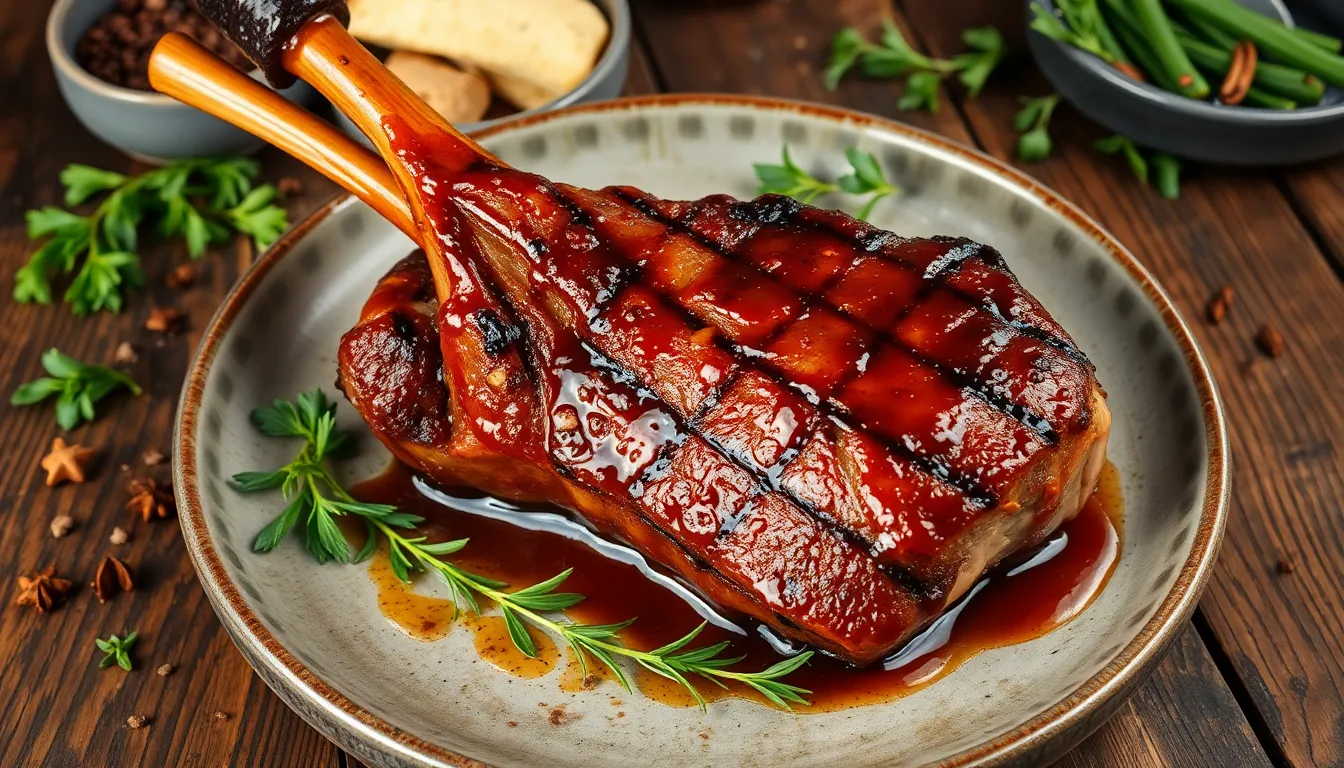
Planning ahead transforms this impressive dish into a stress-free dinner party centerpiece. We recommend preparing the dry rub mixture several days in advance and storing it in an airtight container for maximum flavor development.
Season the Night Before: Apply our signature dry rub to the lamb shanks and wrap them tightly in plastic wrap. Refrigerate the seasoned shanks overnight to allow the spices to penetrate deeply into the meat. This extended seasoning period creates more complex flavors and ensures even distribution throughout each shank.
Complete the Slow Cook Phase: We often finish the entire oven-braising process up to 24 hours before serving. Cook the lamb shanks at 275°F for the full 3-4 hours until fork tender. Allow them to cool completely before storing in the refrigerator with their cooking juices. This method actually improves the final texture as the meat fibers relax and reabsorb moisture.
Reheat Before Grilling: Remove the pre-cooked shanks from refrigeration 30 minutes before final preparation. Gently reheat them in a 300°F oven for 15-20 minutes until warmed through. The meat should reach an internal temperature of 140°F before moving to the grill for the final charring step.
Final Grilling Touch: Brush the reheated shanks with BBQ sauce and grill over medium-high heat for 3-4 minutes per side. This final step creates that essential smoky char while maintaining the tender interior we worked so hard to achieve. The contrast between the caramelized exterior and succulent meat inside makes every bite memorable.
Serving Suggestions
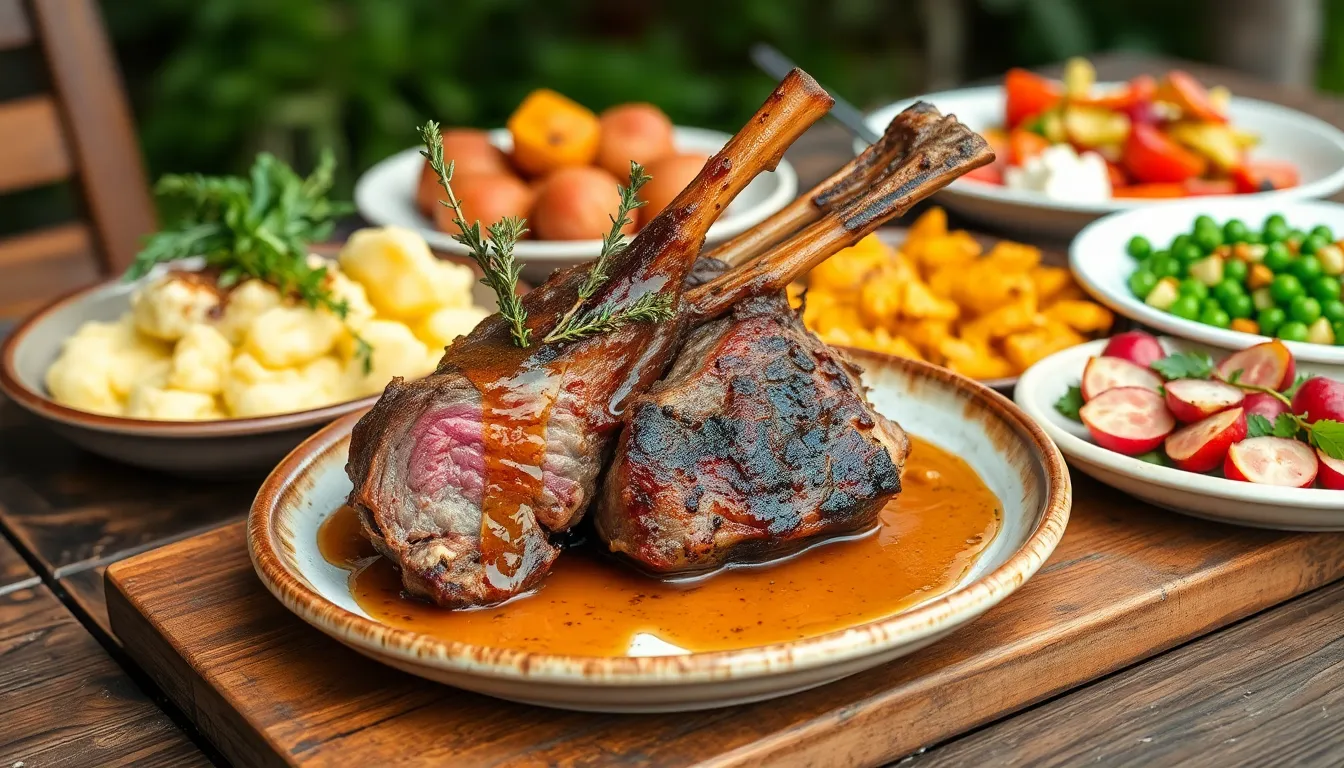
We recommend serving our grilled lamb shanks immediately while they’re still piping hot to maximize their incredible flavor and tender texture. The rich, wine-infused sauce and smoky grilled notes deserve side dishes that complement rather than compete with these bold flavors.
Perfect Starchy Companions
Mashed potatoes rank as our top choice for soaking up the delicious cooking juices. We love how the creamy texture provides the perfect contrast to the lamb’s robust flavors. Polenta offers another excellent option, bringing a subtle corn sweetness that balances the meat’s richness. For a lighter alternative, cauliflower puree delivers the same creamy satisfaction with fewer carbs.
Mediterranean Style Pairings
Lebanese rice becomes our go-to when we want to emphasize the Mediterranean flavors in our lamb shanks. The fragrant rice absorbs the wine sauce beautifully while adding aromatic spices to each bite. Couscous provides a similar effect with its fluffy texture and ability to capture every drop of sauce. Fresh pita bread allows guests to create their own perfect bites, combining the tender meat with sauce and fresh herbs.
Fresh Vegetable Sides
Pea salad brings bright color and fresh flavors that cut through the richness of the lamb. We prepare our garlicky potato salad with extra herbs to echo the seasonings in the meat. Roasted radishes offer an unexpected twist with their sweet, caramelized flavor that pairs surprisingly well with lamb. Sautéed asparagus provides a crisp texture contrast while its earthy notes complement the herb-crusted exterior.
Final Presentation Tips
We always drizzle each lamb shank with honey just before serving for a subtle sweetness that balances the savory elements. Fresh thyme sprigs make the perfect garnish, adding both visual appeal and aromatic finishing notes. The combination of these elements creates a restaurant-quality presentation that showcases the time and care invested in this special dish.
Storage and Reheating
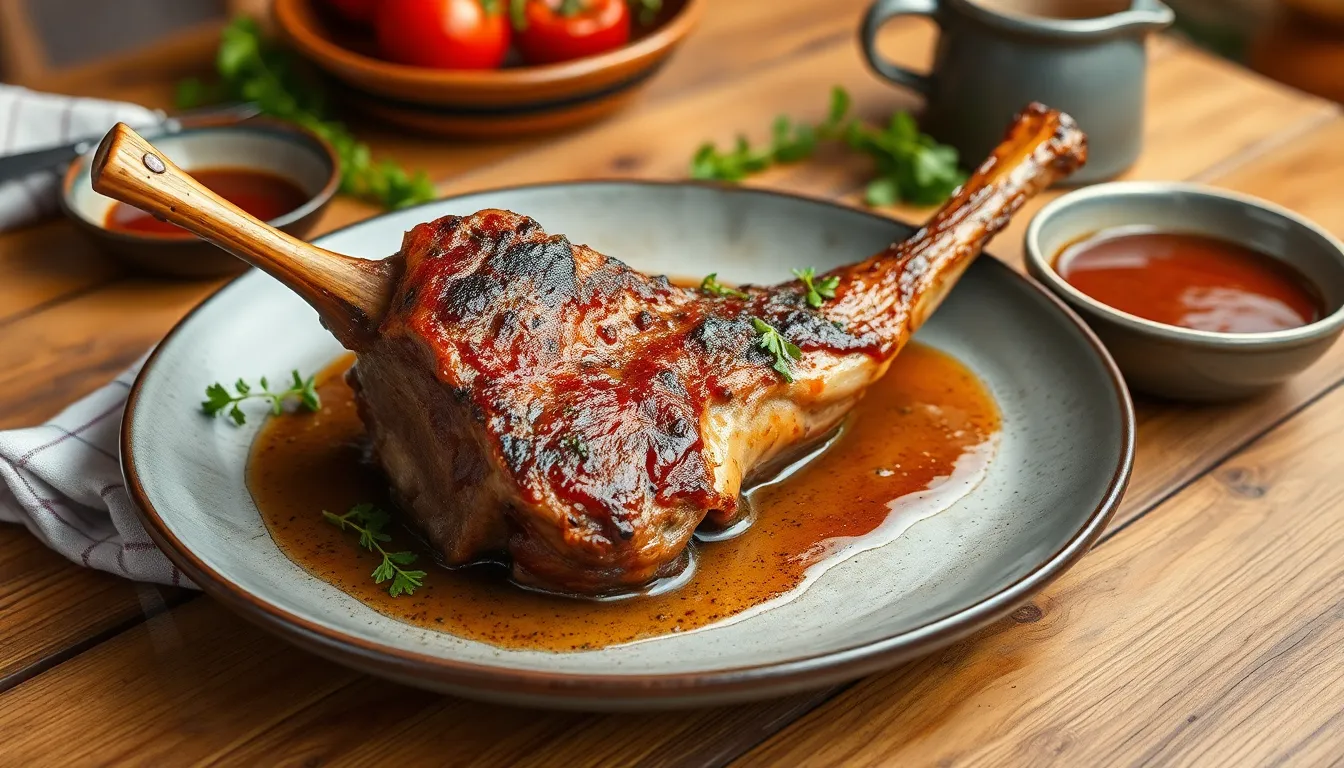
We’ve perfected our storage and reheating methods to ensure your grilled lamb shanks remain as tender and flavorful as when they first came off the grill. Our testing shows that proper storage techniques can extend the life of your lamb shanks while maintaining their exceptional taste.
Proper Storage Techniques
Refrigerator storage works best for short-term needs. We recommend storing cooked lamb shanks in airtight containers for 3 to 4 days maximum. The key lies in keeping the meat with its cooking juices or sauce to prevent drying out. We always store our lamb shanks submerged in their natural juices or braising liquid to maintain moisture levels.
Freezer storage extends your options significantly. Our lamb shanks freeze beautifully for up to 3 to 6 months when properly wrapped. We wrap each shank tightly in plastic wrap followed by aluminum foil to prevent freezer burn. Alternatively, vacuum-sealed bags work exceptionally well for longer storage periods.
| Storage Method | Duration | Temperature |
|---|---|---|
| Refrigerator | 3-4 days | 40°F or below |
| Freezer | 3-6 months | 0°F or below |
Reheating Methods
Oven reheating produces the most consistent results in our experience. We preheat our oven to 300°F and place the lamb shanks in an oven-safe pot with a tight-fitting lid. Cooking time ranges from 15 to 20 minutes for refrigerated shanks and 30 to 35 minutes for frozen ones. Some recipes call for 350°F for 20 to 30 minutes, but we prefer the lower temperature for gentler reheating.
Stovetop reheating offers more control over the process. We use medium heat in a covered pot, allowing the shanks to warm through evenly. This method prevents the meat from drying out while giving us the ability to monitor progress closely.
Microwave reheating works for convenience but requires careful attention. We always cover the dish to retain moisture and prevent the meat from becoming tough. Quick bursts of heat work better than continuous cooking when using this method.
Essential Reheating Tips
Room temperature resting improves reheating results dramatically. We remove refrigerated lamb shanks 30 to 45 minutes before reheating to ensure even warming throughout. This step prevents the exterior from overcooking while the interior remains cold.
Sauce consistency often changes during storage. We add small amounts of broth or water to loosen thickened sauces during reheating. The goal is to restore the original consistency that made the dish so appealing initially.
Moisture retention remains our top priority during reheating. We find that lamb shanks actually improve in flavor after overnight storage, as the seasonings have more time to penetrate the meat. The natural gelatin in the shanks helps maintain tenderness even after reheating, making them excellent candidates for meal prep.
Conclusion
We’ve shared everything you need to transform tough lamb shanks into a show-stopping centerpiece that’ll have your guests talking for weeks. The combination of slow grilling and high-heat finishing creates that perfect balance of tender meat and smoky char that makes this dish truly special.
What we love most about this recipe is its versatility – you can prep ahead for stress-free entertaining or fire up the grill for a weekend family feast. The aromatic marinades and herb butter elevate the natural flavors while ensuring every bite is juicy and flavorful.
Don’t let the cooking time intimidate you. Once you master the low-and-slow technique we’ve outlined your grilled lamb shanks will rival any steakhouse. Pair them with your favorite sides and watch as this impressive dish becomes your go-to recipe for memorable meals.
Frequently Asked Questions
What temperature should I grill lamb shanks at?
Start with indirect heat at 275°F for slow cooking over 3-4 hours. This low temperature breaks down collagen effectively, making the meat tender. Finish with high-heat searing to develop a smoky char and caramelized crust for optimal flavor and presentation.
How long should I marinate lamb shanks?
Marinate lamb shanks for at least one hour, but overnight marination is recommended for optimal tenderness and flavor penetration. The marinade combines olive oil, lemon juice, and dried herbs to create layers of flavor that enhance the final dish.
What internal temperature should grilled lamb shanks reach?
Lamb shanks should reach an internal temperature of 190°F to 205°F for fork-tender results. Use a meat thermometer to ensure accuracy. This higher temperature ensures the collagen breaks down completely, creating that signature fall-off-the-bone texture.
Can I prepare grilled lamb shanks ahead of time?
Yes, prepare the dry rub and season lamb shanks the night before. Complete the slow cooking phase up to 24 hours in advance, storing shanks in their cooking juices. Before serving, gently reheat and finish with high-heat grilling for smoky char.
What are the best side dishes for grilled lamb shanks?
Serve with starchy companions like mashed potatoes, polenta, or cauliflower puree. Mediterranean-style pairings include Lebanese rice, couscous, and fresh pita bread. Fresh vegetable sides like pea salad, roasted radishes, and sautéed asparagus balance the lamb’s richness perfectly.
How do I store leftover grilled lamb shanks?
Store in airtight containers in the refrigerator for 3-4 days, keeping meat submerged in cooking juices to prevent drying. For longer storage, freeze properly wrapped lamb shanks for 3-6 months. The flavors often improve after overnight storage.
What’s the best way to reheat grilled lamb shanks?
Oven reheating at 300°F provides consistent results. Allow meat to reach room temperature first, then add broth or water to restore sauce consistency. Stovetop reheating offers more control, while microwave reheating requires careful attention to retain moisture.
Do I need special equipment to grill lamb shanks?
You’ll need a grill capable of direct and indirect cooking, a heat-proof baking pan for braising, heavy-duty aluminum foil for sealed cooking, and long-handled tongs for safe handling. A meat thermometer is essential for checking doneness accurately.

